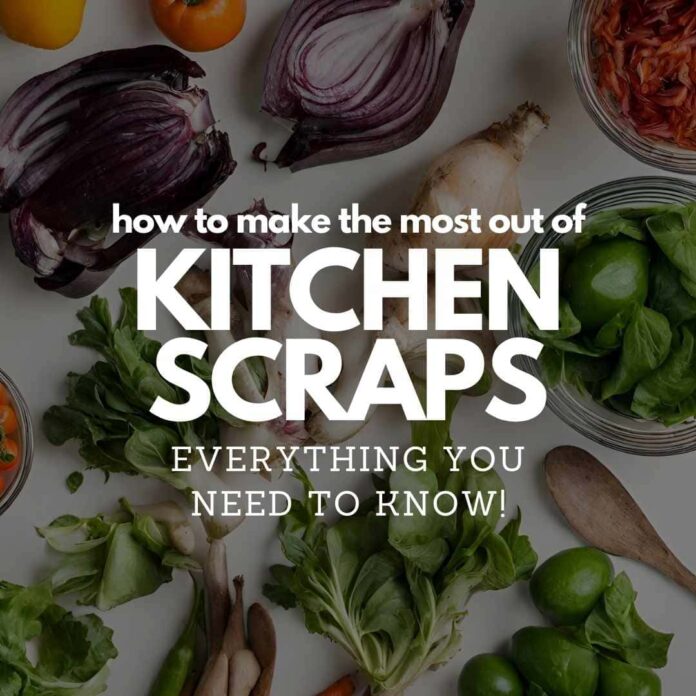Picture this: you’re prepping dinner, a symphony of chopping and stirring. But as you peel your potatoes and trim your broccoli, a mountain of “waste” accumulates. It seems like every delicious meal comes with a side of guilt – the guilt of throwing away perfectly good food scraps.
But what if those Kitchen Scraps weren’t waste at all? What if they were hidden gems, bursting with flavor and potential? This guide unveils the magic of transforming kitchen scraps from destined-for-the-bin castoffs to culinary gold.
From turning citrus peels into zesty jams to creating flavorful broths with veggie trimmings, we’ll show you how to get creative and squeeze every last drop of goodness out of your ingredients. Not only will you reduce waste and save money, but you’ll also become a more resourceful and sustainable cook in the kitchen. So, grab your Kitchen Scraps, unleash your inner alchemist, and get ready to transform trash into treasure!
Did you know that kitchen scraps don’t necessarily have to be thrown away and that you can use them in so many different ways? Let’s see how we can reduce food waste by creatively maximizing kitchen scraps!
When we talk about reducing and recycling food waste, the first thing that comes to mind is composting. While composting is an excellent way to recycle waste, it’s not always the most accessible way for city folks like us.
But here’s the good news: composting isn’t the only way to reduce food waste. In this article, I’m going to share with you 9 fun and creative ways to maximize the use of kitchen scraps:
- Pickled watermelon rinds: Most people tend to throw away watermelon rinds, but they make a delicious snack! Remove the green peel, but leave the white part.
Cut the rind lengthwise and simmer the pieces in a mixture of vinegar, water, salt and sugar until soft. When done, let it cool completely. Place in a glass jar and store in the refrigerator for a crunchy, delicious snack! - Make croutons from old bread: If you have a few days old bread that has gone stale (but still hasn’t developed mold), now is the perfect time to turn it into croutons. Simply cut the bread into small cubes and bake/toast it.
This makes it the perfect addition to soups and salads. You can even pulse it into the mixture to make homemade bread crumbs. - Homemade vegetable stock: When you chop vegetables for your next meal, be sure to save the peels, tops, and other trimmings to make a nutritious vegetable stock. It’s very simple, but packed with flavor and nutrition.
All you have to do is put all the vegetable trimmings in a large pot of water. Bring it to a boil, then reduce the heat and simmer for about 20 minutes. And finished! I have an article about how to make my vegetable stock at home, so make sure you read that. - Freeze leftover herbs: Herbs spoil very quickly, which can lead to a lot of unnecessary food waste. However freezing excess herbs is an excellent way to extend their shelf life. Most herbs, when frozen properly, can easily last between 3 and 6 months. Frozen fresh herbs can be added to so many things, including soups, pasta, curries, and sauces.
Note: Each herb needs to be stored and frozen differently, making it a bit of a challenge, especially if you’re a beginner. But don’t worry, I’ve got you covered! Read this article on how to extend the life of fresh herbs for super useful tips and tricks!
- Use herb stems: Most Indian recipes call for some kind of spice, but usually call for using just the leaves. But did you know that the stems of most herbs, especially coriander, kale, saag, etc. are very nutritious and full of flavor? They can be added to chutneys, and sauces and in tempering to add loads of flavor while reducing waste.
- Coffee grounds as a DIY scrub: If you have a coffee maker, don’t throw away the coffee grounds. Instead, mix them with some milk/cream to make a homemade facial scrub and mask.
Coffee has rich antioxidant properties that help with puffiness, while the texture of coffee grounds makes for a gentle and effective exfoliator. Coffee grounds also provide rich plant fertilizer that has so many benefits. Simply sprinkle coffee grounds directly onto the soil for faster growth, prevent insects, help with water retention, and much more - Snack with potato peels: No rule says potato peels can’t be eaten! Potato peels are rich in fiber and nutrients, making them an excellent addition to your daily diet.
However, it is completely understandable if you don’t want your curries to contain potatoes with their skins on. But here’s how you can use the peeled peel: turn it into a crispy snack!
Spread the potato peels on a baking sheet, season with salt, pepper, and garlic powder, and bake until crispy. Alternatively, you can fry or air fry the peel for a healthier version. - DIY air freshener with homemade peel – Do not throw away the peels of citrus fruits such as oranges, grapefruit, sweet lime, lemon, etc., but use them to make a DIY air freshener.
All you have to do is boil the peels in a little water and you create a natural air freshener for your home. - Eggshell powder as fertilizer – Eggshells are a rich source of calcium, which is necessary for healthy plant growth. Instead of throwing them away, you can use them to make a natural, homemade fertilizer for your plants as follows: Wash the eggshells thoroughly under running water to remove any odors and let them dry for about 2 days.
After 2 days, place the dried eggshells in a mixture jar and grind into a fine powder. Sprinkle directly onto the soil for a powerful, natural fertilizer.
Frequently Asked Questions
- What are some common vegetable scraps?
- Vegetables include, but are not limited to, peels of vegetables such as onions, potatoes, garlic, cucumbers, etc., the leaves of carrots, radishes, etc., the stems and stems of cauliflower, broccoli, kale and spinach, and whatever wilted or browned herbs.
- How can I compost at home?
- If you have the space to compost in a small kitchen, it’s a good idea to start composting. You can buy one small compost bin which is easily available online and place it outside the window or in the dry area of your home.
- Reducing kitchen waste and living more sustainably is not complicated. It’s about being creative and making the most of every part of every ingredient. Making the most of kitchen waste is not only a great way to reduce waste, but it’s also great for the planet.
Similar Topics
Sun Square Pluto Synastry – Is Your Relationship Intense?
Have you ever been drawn to someone with an almost irresistible magnetism? Do your relationships often pulsate with a potent…
Venus in Scorpio
Venus has just moved into Scorpio – a sign she is not at all comfortable in. When Venus is in…
Tarot Date Night: Exploring intimacy and insight through card readings
Are you tired of the same old dinner and movie routine? Want to add an extra layer of intimacy and…
How Saturn Transits Shape Your Resilience and Growth
Life’s Crossroads: Navigating the Impact of Saturn’s Transits Our lives ebb and flow, punctuated by moments of joy and triumph, alongside…
Unveiling Cosmic Insights: June 2023 Horoscope
Welcome, celestial voyagers! As we embark on the journey through the June 2023 Horoscope, the heavens unveil a captivating spectacle…
The Pisces Cycle – February and March 2023
Greetings, celestial explorers! As we journey through the vast expanse of the cosmos, February and March 2023 offer a captivating…







certainly like your website but you need to take a look at the spelling on quite a few of your posts Many of them are rife with spelling problems and I find it very troublesome to inform the reality nevertheless I will definitely come back again
Thank you I have just been searching for information approximately this topic for a while and yours is the best I have found out so far However what in regards to the bottom line Are you certain concerning the supply